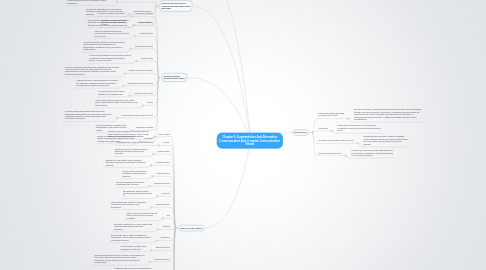
1. What is an AAC System?
1.1. AAC System
1.1.1. Consists of four different components that are used to enhance communication. They include symbols, aids, strategies, and techniques.
1.2. Symbol
1.2.1. Something that stands for something else
1.3. Aided Symbol
1.3.1. Requires a device or accessory that is external to the body to transmit a message.
1.4. Unaided Symbol
1.4.1. Require only one's body such as speaking, gesturing, vocalizing, and signing to represent meaning.
1.5. Static symbols
1.5.1. Do not require movement or change to understand their meaning.
1.6. Dynamic Symbols
1.6.1. Require movement or change to understand their meaning.
1.7. Iconocity
1.7.1. The degree to which symbols visually resemble what they refer to
1.8. Opaque Symbol
1.8.1. Little resemblance to what it represents whereas an iconic symbol is very transparent.
1.9. Aid
1.9.1. Refers to a type of assistive device that is used to send or receive messages.
1.10. Strategy
1.10.1. The third component of an AAC system and is the way symbols are effectively conveyed.
1.11. Technique
1.11.1. Refers to the way in which messages are transmitted - that is, how an individual selects or accesses symbols.
1.12. Direct Selection
1.12.1. A direct motor act that is not dependent on the time.
1.13. Indirect Selection
1.13.1. Individuals with severe motor or sensory impairments can also access their AAC systems with one of three techniques such as scanning, directed scanning and coded access.
1.14. Scanning
1.14.1. A selection set of symbols is presented in a predetermined configuration by either a communication device or a communication partner.
1.15. Coded Access
1.15.1. Requires an individual to use a sequence of movements to select a symbol from a set.
1.16. Fixed Display
1.16.1. Remains the same before and after a symbol is selected.
1.17. Dynamic Displays
1.17.1. Visual and change after a symbol is selected.
1.18. Hybrid Displays
1.18.1. Use a combination of display types on the AAC system.
1.19. Visual Scene Display
1.19.1. Pictures, photographs, or depictions of virtual environments that represent situations, place, or experiences.
2. What are Complex Communication Needs?
2.1. Information Transfer
2.1.1. To give and receive information.
2.2. Social Closeness
2.2.1. Another reason people interact and communicate with one another.
2.3. Social Etiquette
2.3.1. Has to do with being polite and conforming to the social conventions of one's culture.
2.4. Intellectual Disability
2.4.1. Having significant limitations in both intellectual functioning and adaptive behavior, as expressed in conceptual social, and practical adaptive skills.
2.5. Cerebral Palsy
2.5.1. A neuromotor impairment resulting from trauma or damage to the developing child before, during, or soon after birth.
2.6. Autism Spectrum Disorders
2.6.1. A group of developmental disorders characterized by impaired social interaction; difficulty with verbal and nonverbal communication; and unusual, repetitive, or severely limited activities and interests.
2.7. Childhood Apraxia of Speech
2.7.1. A speech disorder characterized by the inability to control the purposeful speech movements and sequences of speech movements.
2.8. Traumatic Brain Injury
2.8.1. An acquired injury to the brain caused by a traumatic event.
2.9. Stroke
2.9.1. Occurs when the blood supply to part of the brain is interrupted or when a blood vessel in the brain ruptures.
2.10. Amyotrophic Lateral Sclerosis (ALS)
2.10.1. A rapidly progressive disease that people may experience a deterioration of speech skills, resulting in unintelligible speech or may experience in poor respiratory functioning.
2.11. Parkinson's Disease
2.11.1. A slowly progressive disease of the basal ganglis in the central nervous system.
2.12. Dementia
2.12.1. Results in significantly impaired intellectual functioning, resulting in disruptions to daily activities and relationships.
3. How are AAC Systems and Complex Communication Needs identified?
3.1. Multidisciplinary Team
3.1.1. A team of professionals conducts an AAC assessment.
3.2. Comprehensive AAC Assessment
3.2.1. After a referral is made, a member of the AAC team contacts the identified person and his or her communication partners to schedule such an assessment.
3.3. Opportunity Barriers
3.3.1. Imposed by other people and prevent an individual's participation in communication activities.
3.4. Access Barriers
3.4.1. Also prevent participation in communication avitibites, but they stem from the capabilites, attitude and sources of the person using AAC
4. How can people with Complex Communication Needs benefit from an AAC System?
4.1. Communication Competence
4.1.1. Many factors impact the attaintment of communication competence are both intrinsic and extrinsic to an AAC user.
4.2. Communication Environment
4.2.1. Inidividuals at the point of independent communication are usually literate and interact with both familiar and unfamiliar communication partners.
4.3. Communication Roles
4.3.1. Any barrier to effective communication must be addressed in treatment to allow complete participation in all desired social and communication roles.
4.4. Social Roles
4.4.1. the roles each person has in society - the different hats people wear.
5. What is AAC?
5.1. Augmentative and Alternative Communication (AAC)
5.1.1. The area of research, clinical and educational practice that "involves attempts to study and, when necessary, temporarily, or permanently compensate for the impairments, activity limitations, and participation restrictions of individuals with severe disorders of speech-language production and/or compensation."
5.2. Multimodal
5.2.1. People use a combination of communication modalities to meet their intended communication goals.
5.3. Complex Communication Needs (CCNs)
5.3.1. Emphasizes the important of speech, language, and/or cognitive abilities for a person's participation in society rather than focusing solely on the disorder.
5.4. Speech Generating Device
5.4.1. A device used to produce words and phrases as an alternative to speaking in situations where he or she is not understood
